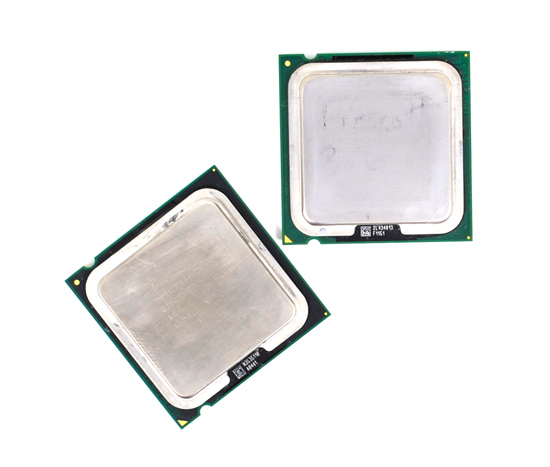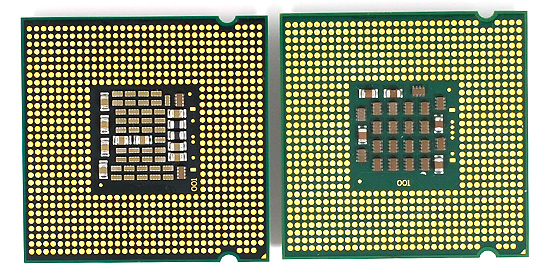The Athlon II X2 & Phenom II X2: 45nm Dual-Core from AMD
by Anand Lal Shimpi on June 2, 2009 12:00 AM EST- Posted in
- CPUs
A Blast from the Past: The Pentium 4 660 and the Pentium Extreme Edition 955
Two weeks ago I asked everyone what older CPUs they’d like to see included in one of our quietly introduced features on AnandTech: Bench. I got requests for everything from original Pentium processors to VIA’s Nano. While I’m working on adding additional data to the tool I just finished testing two older CPUs over the weekend that I thought would be useful in this review: the Pentium 4 660 and the Pentium Extreme Edition 955.

Pentium Extreme Edition 955 (left) and Pentium 4 660 (right)
Both of these CPUs are from 2005. The Pentium 4 660 was a single-core processor based on Intel’s infamous Prescott core. The processor had a 2MB L2 cache and Hyper Threading support; it ran at 3.6GHz, a higher clock speed than any current AMD or Intel processor.
The Pentium EE 955 is based on two separate Intel 65nm Presler cores on one package (ah, remember the early days of dual-core?). The 955 ran at 3.46GHz but had HT enabled, allowing it to execute 4 threads at the same time.

Pentium Extreme Edition 955 (left) and Pentium 4 660 (right)
When the Pentium 660 debuted it cost $605, while the Pentium EE 955 would set you back $999 in 2005. These were some of the fastest Pentium 4s ever released and you’ll see them compared to a couple of ~$90 CPUs here today.
The Test
| Motherboard: | Intel DX58SO (Intel X58) Intel DX48BT2 (Intel X48) MSI DKA790GX Platinum (AMD 790GX) Gigabyte GA-MA790GP-DS4H (AMD 790GX) Gigabyte GA-MA790FX-UD5P (AMD 790FX) |
| Chipset: | Intel X48 Intel X58 AMD 790GX AMD 790FX |
| Chipset Drivers: | Intel 9.1.1.1012 (Intel) AMD Catalyst 8.12 |
| Hard Disk: | Intel X25-M SSD (80GB) |
| Memory: | G.Skill DDR2-800 2 x 2GB (4-4-4-12) G.Skill DDR2-1066 2 x 2GB (5-5-5-15) Qimonda DDR3-1066 4 x 1GB (7-7-7-20) Corsair DDR3-1333 4 x 1GB (7-7-7-20) |
| Video Card: | eVGA GeForce GTX 280 |
| Video Drivers: | NVIDIA ForceWare 180.43 (Vista64) NVIDIA ForceWare 178.24 (Vista32) |
| Desktop Resolution: | 1920 x 1200 |
| OS: | Windows Vista Ultimate 32-bit (for SYSMark) Windows Vista Ultimate 64-bit |










55 Comments
View All Comments
Gary Key - Tuesday, June 2, 2009 - link
The X2 6400+ is in the charts now and you can always use our Bench tool to compare a whole litany of processors against each other. AMD is currently phasing out of 90nm production and even several 65nm products will be phased out this year as they ramp the 45nm production.Spoelie - Thursday, June 4, 2009 - link
WOW, it really amazes me how little performance has improved. Athlon II X2 750 (3ghz) is barely faster in most benchmarks than a Athlon X2 6400+ (3,2ghz), and loses in 1 or 2.So the phenom core redesign buys around 300mhz around 3ghz, or only 10%. Everything else that improved in phenom is uncore.
And this while the original is at 90nm and the new one is 45nm, what a waste of potential. It seems to me AMD could've tried a little harder with the Athlon II.
Spoelie - Tuesday, June 2, 2009 - link
There's a small util/service out there that brings phenom II cnq behaviour from vista over to windows xp (phenom II's cnq behaves like phenom I's cnq under windows xp). It does this by disabling standard cnq (set power management not on "minimal") and implementing pstate changing itselfhttp://home.comcast.net/~pmc650/site/?/page/CNQ_Ph...">http://home.comcast.net/~pmc650/site/?/page/CNQ_Ph...
Maybe it can do the same for the Athlon II X2 on vista...
mohindar - Tuesday, June 2, 2009 - link
Hello Anand,It will be very nice to provide some benches regarding desktop virtualization, like how windows-xp usage on this chip and so on...
plonk420 - Tuesday, June 2, 2009 - link
i'm curious to see this on the bench!mapesdhs - Tuesday, June 2, 2009 - link
I'm beginning to wonder whether AMD/Intel are making the same mistake
we saw last year with gfx cards, ie. too many different options. What
is the target market for the new AMD CPUs? Many retailers seem to
offer just a small selection.
Any chance you could add an i7 920 and a 6000+ to the tables please?
The former for completeness, the latter to show how the newer AMD
parts stack up against a typical older product. I'd been hoping for
a suitable replacement for the 6000+ in my ASUS board, but still nothing (no BIOS support).
Atm it looks like my next system will be an i7 920 setup (core task
is video encoding). In the past there's been lots of talk about the
higher cost of an i7 system, but looking around yesterday, I was
surprised at how small the difference has now become. The i7 920 is
only 18% more than the Ph2 955 BE. Expecting a larger difference for
the mbd cost, I found an X58 board from Gigabyte (the GA-EX58-UD3R,
135 UKP from LambdaTek) right in the middle of the price range of
typical AM3 boards. They both use DDR3, so that isn't a factor. I
was going to build a Ph2 955 BE system for my brother as his next
gaming rig, but with such small price differences now in play, the
i7 looks more sensible.
Oh, a typo on the first page perhaps? Surely it should be 2 cores for
the Athlon64 X2?
Ian.
smilingcrow - Tuesday, June 2, 2009 - link
Judging by other reviews your choice of using the x264 HD Bench Pass 1 for the Power Consumption comparison doesn’t give a true representation of the situation.As expected other reviews shows the Athlon II X2 having a noticeably lower power consumption under typical loads.
The Phenom II X2 has too much extra circuitry to have lower power consumption and I’m surprised that you didn’t deduce that something was amiss.
Anand Lal Shimpi - Tuesday, June 2, 2009 - link
As I mentioned on the power consumption page, I'm guessing it has more to do with the current level of BIOS support for the Athlon II's power management. AMD is expecting a much better situation in the coming weeks.Take care,
Anand
Eeqmcsq - Tuesday, June 2, 2009 - link
The one comparing various Athlon X2 specs. The table says the Athlon 64 X2 has 4 cores.Anand Lal Shimpi - Tuesday, June 2, 2009 - link
Woops, thank you :)-A